 |
Convert MP4 to AIFF
|
MP4 to AIFF Converter converts MP4 files to
AIFF. The converter focuses on AIFF file that supports almost all codecs
in AIFF specification, for example, pcm 8-bit, pcm 16-bit, pcm 24-bit, pcm 32-bit,
pcm 32-bit float, pcm 64-bit float, a-Law, mu-Law, IEEE 754 float, ima4, gsm,
dwvw, and so on. The software also supports common file format such as MP3, AAC, MP2, M4R (iPhone ringtone), MMF, WMA, M4A (MPEG-4 audio), OGG,
etc. It could convert THD to AMR, WMV to AMR, MP4 to OGG, MOV to MMF, AMR to MKA, DIVX to AIFF, and so on.
The software is very easy to use and supports batch conversion.
It is full compatible with 32-bit and 64-bit Windows 10/8/7/Vista/XP/2000.

What is MP4?
MPEG-4 Part 14, formally ISO/IEC 14496-14:2003, is a multimedia container format
standard specified as a part of MPEG-4. It is most commonly used to store digital
audio and digital video streams, especially those defined by MPEG, but can also
be used to store other data such as subtitles and still images. Like most modern
container formats, MPEG-4 Part 14 allows streaming over the Internet. The official
filename extension for MPEG-4 Part 14 files is .mp4, thus the container format
is often referred to simply as MP4.
MPEG-4 is a patented collection of methods defining compression of audio and
visual (AV) digital data. It was introduced in late 1998 and designated a standard
for a group of audio and video coding formats and related technology agreed upon
by the ISO/IEC Moving Picture Experts Group (MPEG) (ISO/IEC JTC1/SC29/WG11) under
the formal standard ISO/IEC 14496 - Coding of audio-visual objects. Uses
of MPEG-4 include compression of AV data for web (streaming media) and CD distribution,
voice (telephone, videophone) and broadcast television applications.
MPEG-4 absorbs many of the features of MPEG-1 and MPEG-2 and other related
standards, adding new features such as (extended) VRML support for 3D rendering,
object-oriented composite files (including audio, video and VRML objects), support
for externally-specified Digital Rights Management and various types of interactivity.
AAC (Advanced Audio Coding) was standardized as an adjunct to MPEG-2 (as Part
7) before MPEG-4 was issued.
MPEG-4 is still a developing standard and is divided into a number of parts.
Companies promoting MPEG-4 compatibility do not always clearly state which "part"
level compatibility they are referring to. The key parts to be aware of are MPEG-4
part 2 (including Advanced Simple Profile, used by codecs such as DivX, Xvid,
Nero Digital and 3ivx and by Quicktime 6) and MPEG-4 part 10 (MPEG-4 AVC/H.264
or Advanced Video Coding, used by the x264 encoder, by Nero Digital AVC, by Quicktime
7, and by high-definition video media like Blu-ray Disc).
What is AIFF?
Audio Interchange File Format (AIFF) is an audio file format standard used for
storing sound data for personal computers and other electronic audio devices.
The format was co-developed by Apple Computer in 1988 based on Electronic Arts'
Interchange File Format (IFF, widely used on Amiga systems) and is most commonly
used on Apple Macintosh computer systems. AIFF is also used by Silicon Graphics
Incorporated. The audio data in a standard AIFF file is uncompressed big-endian
pulse-code modulation (PCM). There is also a compressed variant of AIFF known
as AIFF-C or AIFC, with various defined compression codecs.
Standard AIFF is a leading format (along with SDII and WAV) used by professional-level
audio and video applications, and unlike the better-known lossy MP3 format, it
is non-compressed (which aids rapid streaming of multiple audio files from disk
to the application), and lossless. Like any non-compressed, lossless format, it
uses much more disk space than MP3¡ªabout 10MB for one minute of stereo
audio at a sample rate of 44.1 kHz and a sample size of 16 bits. In addition to
audio data, AIFF can include loop point data and the musical note of a sample,
for use by hardware samplers and musical applications.
The file extension for the standard AIFF format is .aiff or .aif. For the compressed
variants it is supposed to be .aifc, but .aiff or .aif are accepted as well by
audio applications supporting the format.
- Free Download
MP4 to AIFF Converter
- Install the software by instructions
- Launch MP4 to AIFF Converter
- Choose MP4 Files
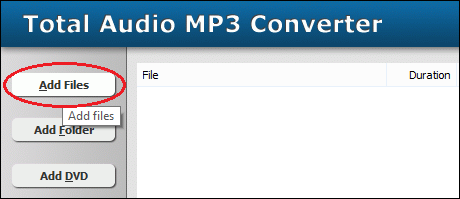
Click "Add Files" to choose MP4 files and then add them
to conversion list.
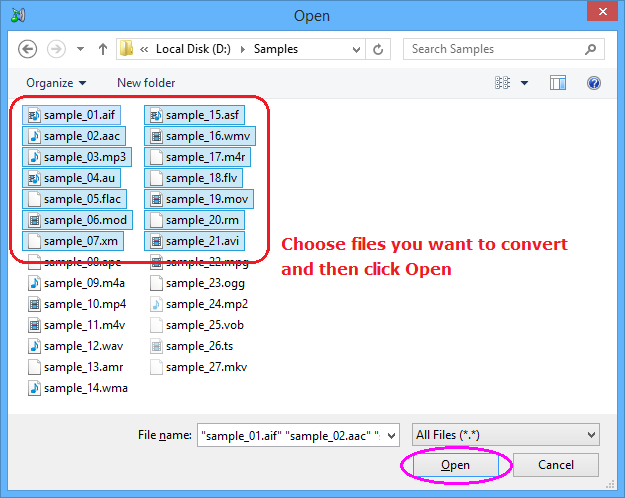
Choose one or more MP4 files you want to convert and then click Open.
- Choose "to AIFF"
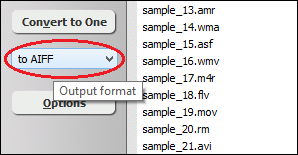
- Convert MP4 to AIFF
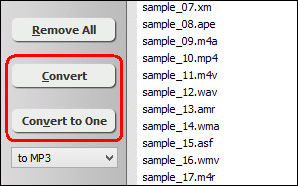
Click on "Convert" to convert MP4 files to AIFF format; alternatively,
click on "Convert to One" to convert all files in list and
combine to a single one AIFF file.

The software is converting MP4 files to AIFF format.
- Play and Browse AIFF File
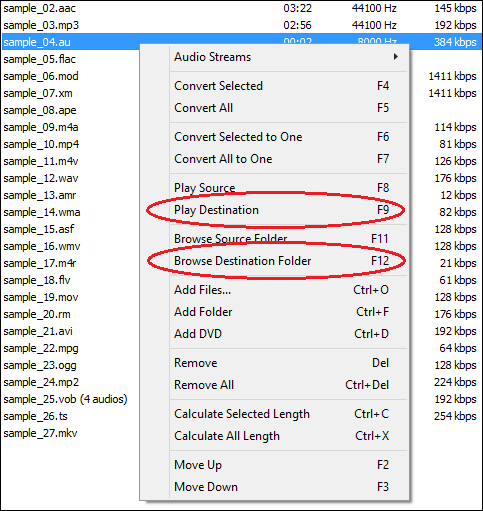
When conversion completes, you could right-click on converted file and choose
"Play Destination" to play the AIFF file; or choose "Browse
Destination Folder" to open Windows Explorer to browse the outputted AIFF
file.
Top
MP4 to AIFF Converter is 100% clean and safe to install.
It's certified by major download sites.

MP4 to AIFF Related Topics:
|

